Baseball Glove Size Charts To Choose the Perfect Fit
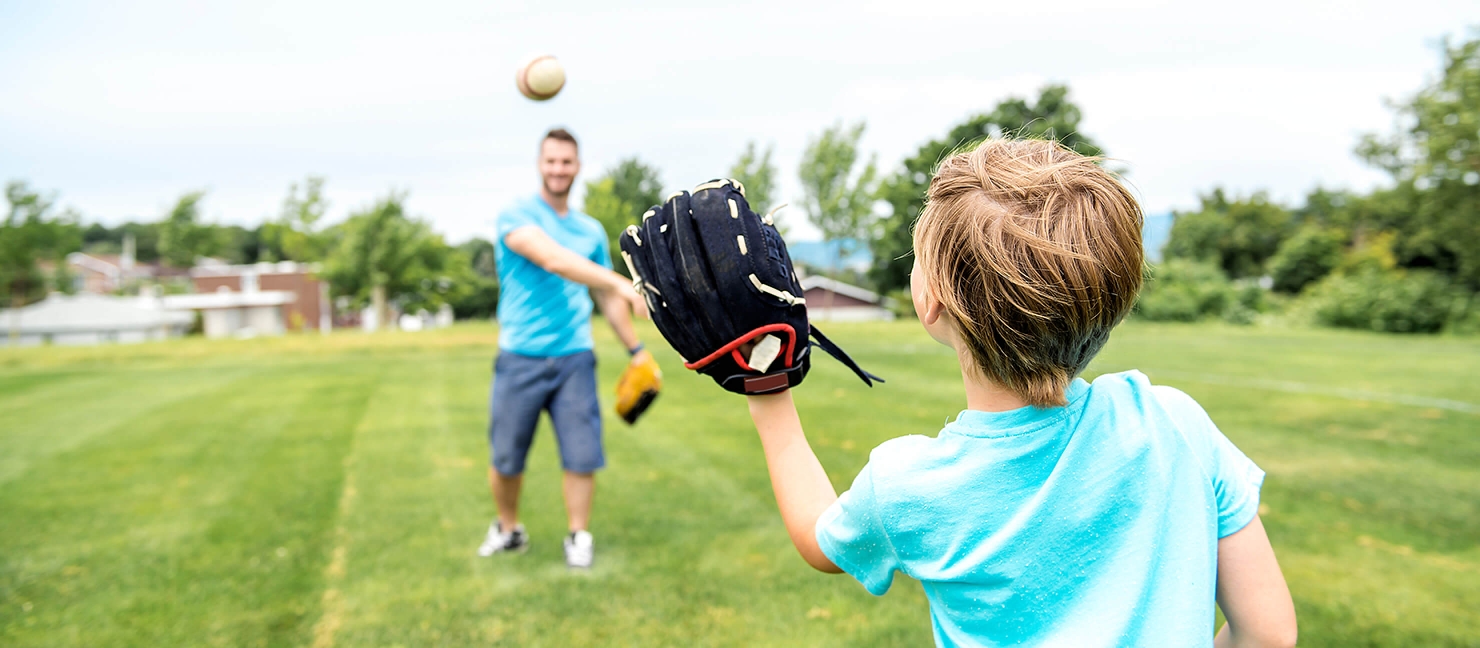
Is the fit of your baseball glove hindering your performance on the field? When you’re on the diamond, you want to hear the umpire shout, “OUT!” That means you can’t let the confusion of choosing the perfect glove fit be what hold you back.
Keep reading for our detailed baseball glove size charts to help you find the best fit for your game and hand in four simple steps:
Baseball Glove Sizing Guide
Whether you need an adult baseball glove, a youth glove, or a glove for t-ball players, focus on these factors: the glove size, your throwing hand, as well as the fit and the feel.
| Youth Baseball Glove Size Chart | |||||
|---|---|---|---|---|---|
| Position | Up to 5 Years Old | 6-7 Years Old | 8-10 Years Old | 11-12 Years Old | |
| Infielder | 8" - 10.5" | 8" - 10.5" | 10" - 11.5" | 11" - 12" | |
| Outfielder | 9" - 10.5" | 9" - 10.5" | 10" - 11.5" | 11" - 12" | |
| Pitcher | 8” - 10.5" | 8" - 10.5" | 10.5" - 11" | 11" - 12" | |
| Catcher* | 29.5" - 30" | 29.5" - 30" | 30" - 32" | 30" - 32.5" | |
| First Base | 11.5” | 11.5” | 11.5" - 12" | 11.5" - 12" | |
| *You measure catcher’s mitts and baseball gloves with different standards/techniques. | |||||
Baseball gloves give players protection, comfort, and control on the diamond. The construction, fit, and webbing type of your glove can affect your performance on the field, so selecting the right glove type is crucial.
| Adult Baseball Glove Size Chart | |||||
|---|---|---|---|---|---|
| Position | 13-14 Years Old | High School & College Ages | |||
| Infielder | 11" - 12" | 11" - 12.25" | |||
| Outfielder | 11.75" - 12.75" | 12.5" - 12.75" | |||
| Pitcher | 11.5” - 12" | 11.5" - 12.5" | |||
| Catcher* | 30" - 32.5" | 32.5" - 34" | |||
| First Base | 11.5” -12" | 12” - 13" | |||
| *You measure catcher’s mitts and baseball gloves with different standards/techniques. | |||||
What Size Baseball Glove Do I Need?
A combination of a player’s age, hand size, and position largely determines the size of a baseball glove. When you’re choosing a glove, where you stand on the field (or outside of it) matters. For example, outfielders need bigger glove sizes to provide players more reach whenever batters strike the ball to left or center field.
How should a baseball glove fit? Baseball gloves are supposed to be tight. But they should not hinder your hand’s blood circulation nor should they slide off your hand.
By nature, the materials manufacturers use to make baseball gloves are usually stiff. However, they will loosen up with continued use.
- Size up when your glove prevents you from moving your fingers enough to accommodate catching the ball or makes your hand feel numb.
- Size down if it slides down your hand when you relax it at your side. As tempting as it may be to use an older sibling’s old glove, the glove should always fit the individual player.
How to Measure Your Baseball Glove Size

How to Measure Your Baseball Glove Size
In order to choose the right range of baseball glove sizes, you’ll need to know the suggested range for you or the player’s age so you know what to look for in the store. See which size fits best in this range, and size up if you need to.
If you’re unable to find the length on the glove, measure its size:
- Place a tape measure at the heel of the baseball glove.
- Measure from the heel to the tip of the index finger.
- Note or write down the measurement.
Expert Tip:
A baseball glove’s marking may fade over time as you use it. If you’re looking to upgrade from your old or too-small glove, follow the same steps above!
Catcher’s Mitt Sizing & Measuring Tips

Catcher’s Mitt Sizing & Measuring Tips
A catcher’s mitt is sized in circumference. You can use our baseball glove size charts to help you find the best fit. When you need to measure a catcher’s mitt, you can follow these steps:
- Flatten the palm/pocket side of the mitt down on a stable surface as much as you can.
- Place a soft tape measure at the heel of the mitt.
- Work the tape measure all the way around the outside of the catcher’s mitt until you circle back around to the heel.
- Note or write down the measurement.
Baseball Glove Web Types by Position
Just like how baseball gloves’ sizes vary by position, so do the types of glove webs we recommend! If you're brand new or shopping for youth baseball and are unsure of the exact field position to buy for, a multipurpose glove can help the player learn and practice different positions.
Best Infielder Baseball Glove Web Types
Infield gloves often utilize a smaller, five-fingered design with a shallow pocket for quick transfers from the glove to releases from the throwing hand. Smaller gloves with wider webbing will make it easy to sift through dirt to scoop up ground balls.
While most infielders can benefit from the following gloves, you may want to experiment a little depending on your specific position and play style or other preferences. For example, third basemen may prefer close webbing since they tend to field hard hits, which require more strength and support.
H-Web
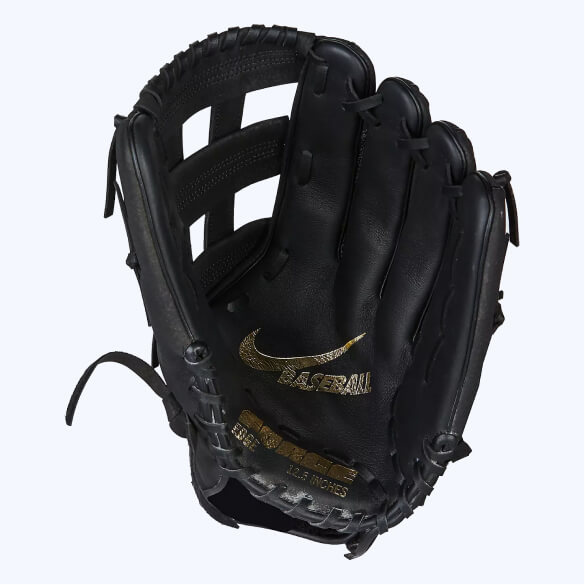
-
Sturdy, open web fields hard-hit balls
-
Allows dirt and debris to fall right
through
Glove Featured: Nike Force Edge H-Web 12.5 in Pitcher/Infield/Outfield Baseball Glove
I-Web

-
Consistently aligns in the same spot for quick turns and exchanges
-
Dirt and debris fall right through
Glove Featured: Marucci Youth Krewe M Type I-Web 11.25 in Baseball Glove
Modified Trapeze

-
Creates a deeper pocket for catching fly balls
Glove Featured: Marucci Adults' Oxbow M Type T-Web 11.75 in Baseball Glove
Single/Double Post

-
Its deep pocket makes throwing the ball across the field easier
Glove Featured: Wilson 2023 A2000® 1785SS 11.75 in Outfield Baseball Glove
Expert Tip:
For infielders, the choice between the single post and double post web type often boils down to personal preference.
Best Outfielder Baseball Glove Web Types
Want to know what an outfielder’s best bets for securing those fly balls are? Outfield baseball gloves are usually longer and offer the player additional reach and a deeper pocket to secure the catches. Most outfielders will prefer closed webbing for extra security.
H-Web (or Dual Post)
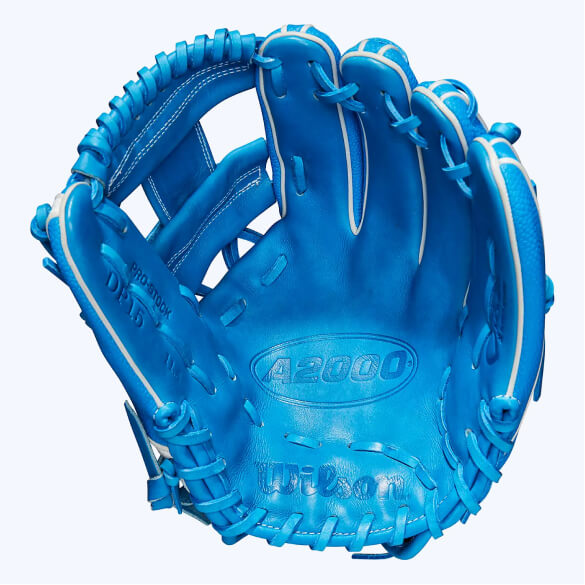
-
Offers outfielders visibility when catching a ball
-
The web design creates a deeper pocket for easy outfield catches
Glove Featured: Wilson 2023 A2000 Pedroia Fit DP15 Fielding Glove
Trapeze

-
Offers better shielding from the sun for those flyballs
-
Has a deeper pocket than other web types for easy outfield catching
Glove Featured: Rawlings Men's Player Preferred 12.75 in Outfield Baseball Glove
Modified Trapeze

-
The extra strip of leather on top of the web gives the baseball glove better stability
-
A great option for outfielders, infielders, and even pitchers
Glove Featured: Marucci Adults' Oxbow M Type T-Web 11.75 in Baseball Glove
Basket Web
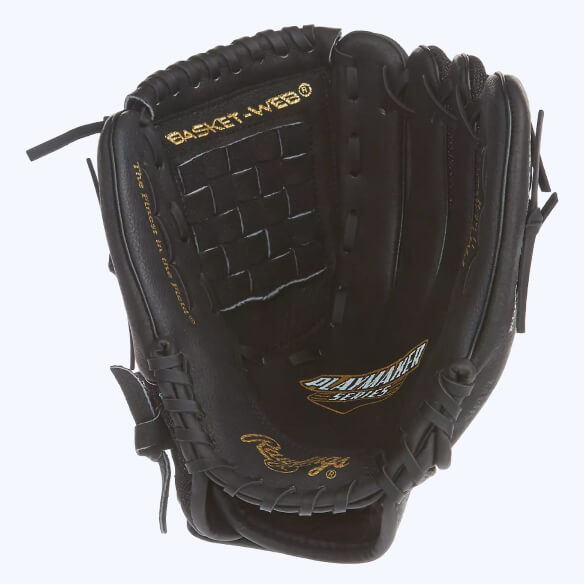
-
Conceals the ball with ease for players
-
Usually has a stronger, shallower pocket
-
Provides a player’s glove extra structure and support
Glove Featured: Rawlings Youth Playmaker 11 in Baseball Glove
Best Pitcher Baseball Glove Web Types
Pitchers rely a lot on concealment. The best gloves for the job often feature a deep pocket and a closed webbing system to help pitchers mask their next throw. Here are the best baseball glove web types we recommend for pitchers:
Two Piece
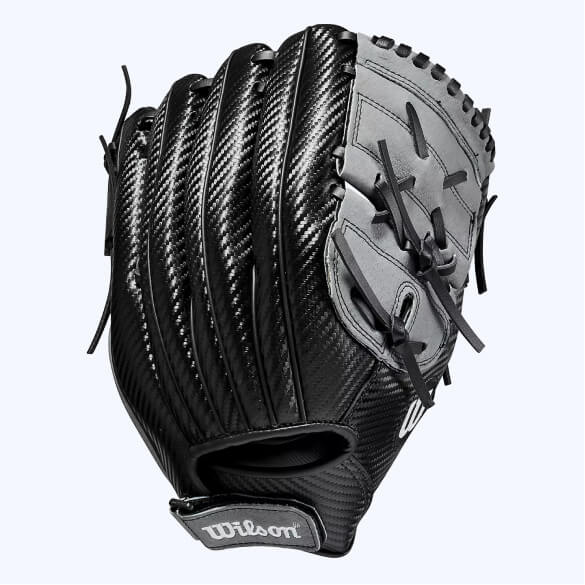
-
Two pieces stitched together to form a tight pocket for secure catches
-
Heavier design because it requires more material
Glove Featured: Wilson Youth 2021 A360 12-in Utility Baseball Glove
Modified Trap

-
Has an extra leather strip at the top for extra structure and support
-
Offers fantastic utility and can be used for many positions
Glove Featured: Rawlings 11.75" Adult Sandlot Series Mod Trap Baseball Glove
Basket Web

-
Small, intertwining straps woven together to form a completely closed off basket
pattern -
Despite its rigid design, it does maintains some flexibility
Glove Featured: Mizuno Pro Corey Kluber 12 in Baseball Glove
Dual Post

-
Similar to single post and H-web designs just with two, thicker posts (vertical leave strips)
-
These help conceal the baseball from the batter’s view
Glove Featured: Wilson Youth 2021 A500 11.5-in Infield Baseball Glove Right-Handed
Best Catcher Baseball Glove Web Types
A catcher’s mitt is fingerless, is heavily padded, and has tight, shallow pockets. They help supply the control that catchers need and reduce the sting while increasing the transfer speed. Catcher’s mitts are sold by circumference.
-
Players 13 and younger should wear a 32-32.5”
-
Players between 14-15 years old should wear between a 32.5-33”
-
Players 16 and older should wear at least a 33”
Closed Webbing
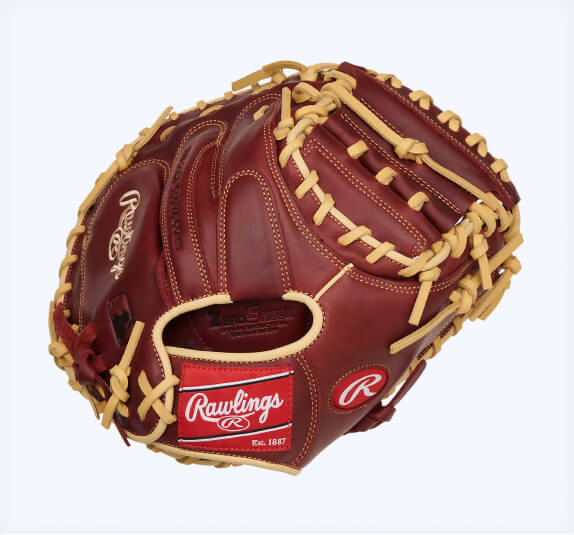
Closed Webbing
A catcher’s mitt comes in two closed webbing design types: a half-moon web & a one-piece web. Closed web gives catchers the needed support for those extra-fast pitches as well as conceals your pitch calls.
-
Half Moon Web: Small, intertwining straps woven together that form a completely closed off basket pattern yet maintain some flexibility
-
One-Piece Web: Similar to single post and H-web designs just with two, thicker posts (vertical leave strips) help conceal the baseball from the batter’s view
Glove Featured: Rawlings 33 in Youth Catchers Baseball Mitt
Best First Baseman Baseball Glove Web Types
First baseman baseball gloves offer a long, wide mitt design ideal for handling the challenges presented to a first baseman: scooping up grounders and catching missile-like throws from teammates in the infield. Most first base players will want deep pockets and some cushion to keep the ball secure in their glove.
Modified H-Web

-
Open-webbing just like the H-Web style with one key difference: an added top leather strip to expand your catch radius
Glove Featured: Rawlings 12.5 in Youth First Base Baseball Mitt
Single Post

-
Creates a consistent pocket for receiving the ball, with ample flexibility and
visibility
Glove Featured: Marucci Youth Krewe M Type Single Post Web 11.5 in Baseball Glove
Expert Tip:
The difference between a baseball glove and a baseball mitt is that gloves have fingers and mitts do not. Therefore, first basemen and catchers often use mitts, while the other players use gloves.
Baseball Glove Materials
Baseball gloves mostly come in either synthetic material or a type of leather. While each type may affect your performance a bit, which one you choose ultimately comes down to personal preference.
-
Younger players may prefer cowhide or synthetic leather for less break-in time.
-
For a game-ready feel, older players may prefer softened, oil-treated leather gloves.
So what’s the real difference between leather and synthetic baseball gloves? Below, we dive into each type of baseball glove material and give you a brief overview of how they compare to each other:
Synthetic Material

Synthetic Material
-
Quick break-in period, lightweight, durable, water resistant
-
Most affordable
-
Typically mesh or synthetic leather material
Leather

Leather
-
Lighter in weight, yet still very durable
-
Quicker break-in period
-
More affordable
-
Cowhide, pigskin, kip leather
Premium Leather

Premium Leather
-
Heavier options geared toward older and Pro Series players
-
Has a longer break-in period, but usually more expensive
-
Full-grain hide, steerhide
Expert Tip:
Learn how to break in your baseball glove fast with the best tools, tips, and tricks from Academy’s baseball experts.
How Do You Clean a Baseball Glove?
Assemble a basic cleaning kit to clean your baseball glove. Yours could include a scrub brush (toothbrushes, coffee brushes, horse hair brushes, and shoe brushes all work great for different things and gloves), glove conditioner (especially for leather gloves), glove cleaner/oil, water & dishes, and a clean towel, rag, or sock.
Once you’ve got your supplies together, try this simple way to clean your baseball glove:
- Step 1: Remove large clumps of dirt with the brush.
- Step 2: Add your cleaner of choice to the cloth. Next, use the cloth to gently remove any remaining dirt.
- Step 3: If using a leather glove, apply a dime-sized amount of glove oil to a new cloth. Too much oil will leave a residue that can gunk up your glove and accumulate more dirt. Applying your oil directly to the glove will shorten the life of a new glove.
- Step 4: Work the glove oil into the leather evenly — starting at the palm. Move to the breakpoint, and finally the web and laces. If your glove is new, you can use this time to stretch and work the rigid parts of your glove to help break it in.
- Step 5: Leave your glove in a warm area for 24 hours to allow the oil to absorb into the leather.
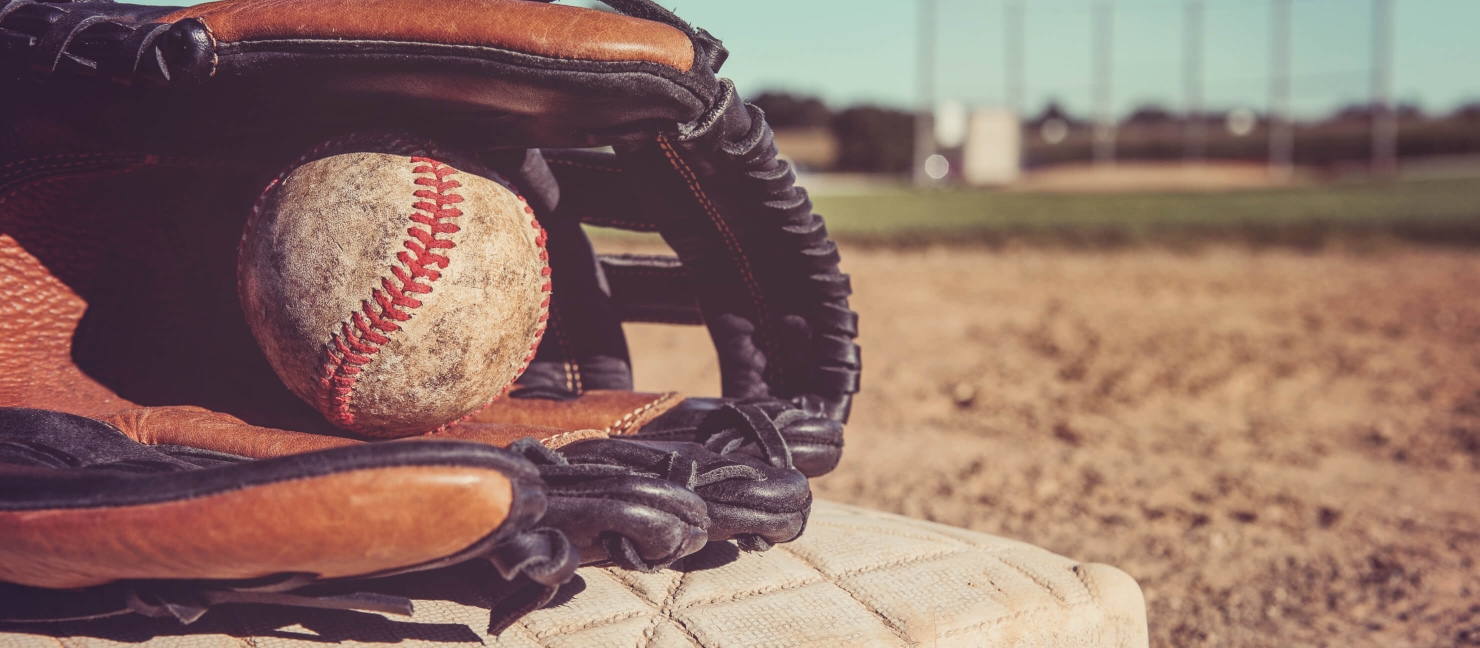
Want to know how you clean synthetic baseball gloves? Clean synthetic gloves using the same steps we detail for cleaning a leather glove. We caution you from throwing a baseball glove of any kind into the washing machine/dryer.
Just because a glove is synthetic doesn’t necessarily mean it’s free of leather. Synthetic leather — just like real leather — can still crack and lose its integrity when cleaned this way.
What Are the Parts of a Baseball Glove?
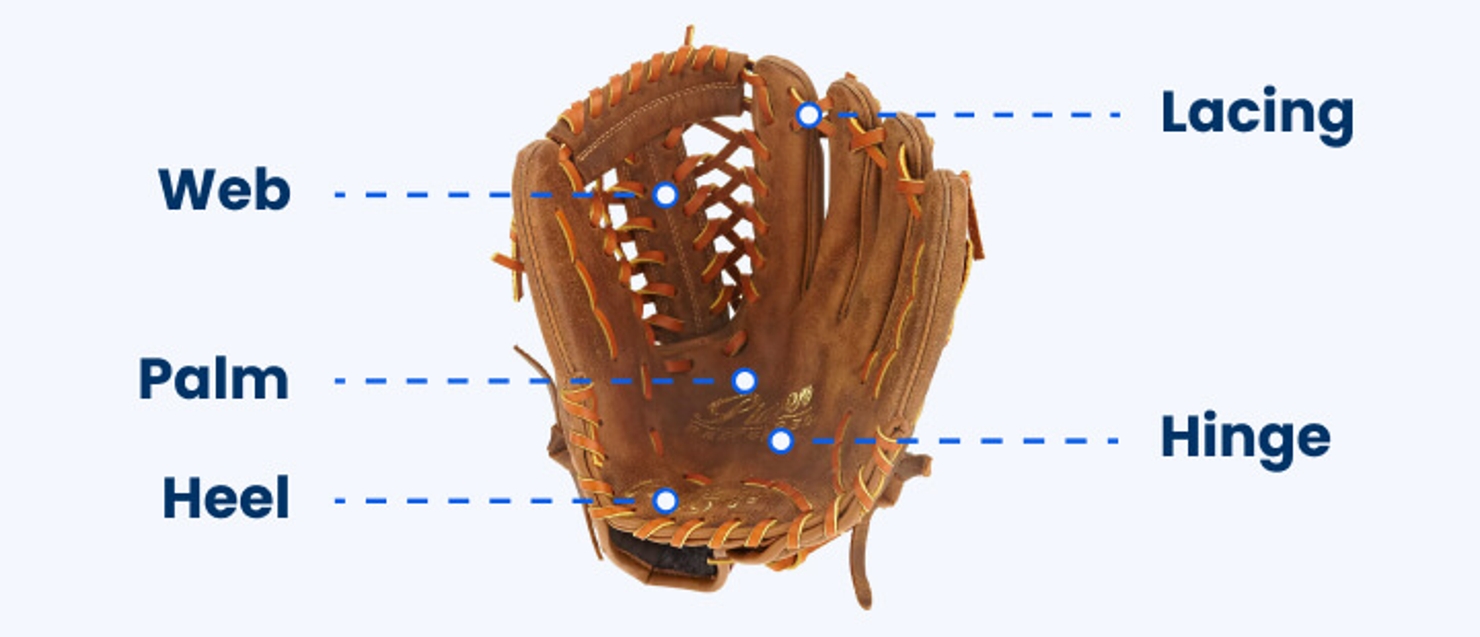
-
Heel: Located below the palm directly above the point where your hand meets your wrist, the heel of your gloves makes up the lower portion of the palm side.
-
Wrist adjustment: Some gloves (usually youth gloves) include this feature, which adjusts to make the glove tighter or looser.
-
Lacing: The glove’s lacing system is what fastens the fingers of your glove together, supplying the much-needed structure of your mitt.
-
Hinge: Hinges allow your glove to open and close with ease. This translates into more secure catches and ball handling.
-
Palm: The 'pocket' in the center of your glove that catches the ball is called the palm. Palms offer safe and protective padding beneath the leather layers to protect your hand from impact.
-
Web: Webbing is the area of the glove between your thumb and first finger. Made of tightly woven pieces of leather, webs ensure consistent catching and ball control.
What Hand Do You Wear a Baseball Glove on?
-
If you throw with your right arm, wear a Right-Hand Throw (RHL) glove on your left hand.
-
If you throw with your left arm, wear a Left-Hand Throw (LHT) glove on your right hand.
Next Steps
Knowing the parts of a baseball glove, how glove types change based on positions, which materials they can be made from, and how to get your best fit are key to choosing a baseball glove. Once you’re ready to get started, check out our wide variety of baseball gloves online.
Looking to learn more? Get more Expert Advice on baseball here.
 Gift Cards
Gift Cards Hot Deals
Hot Deals Clearance
Clearance

